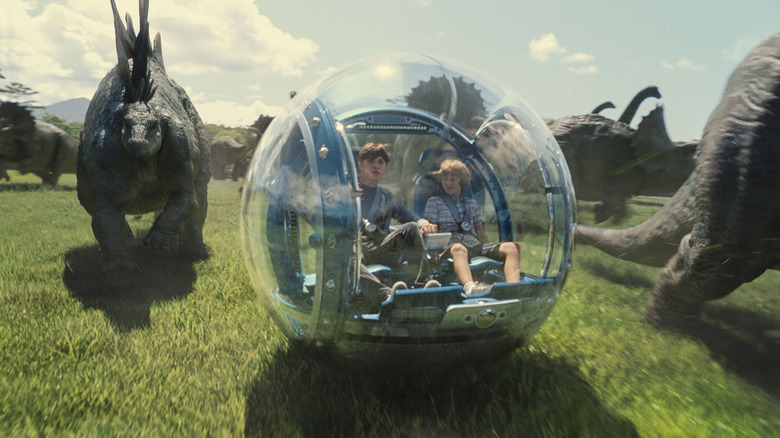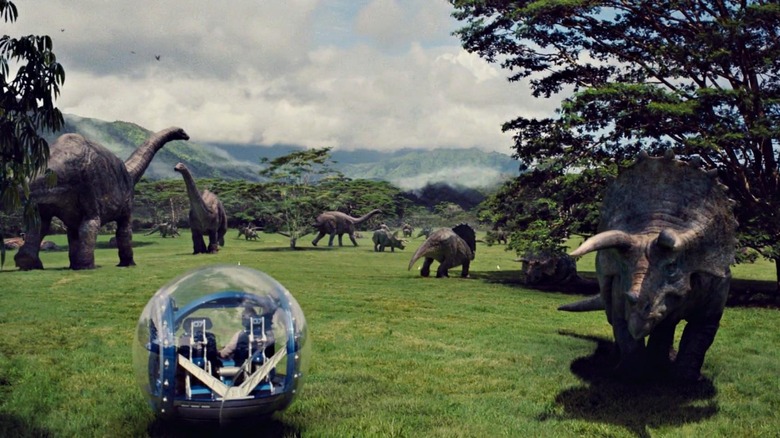How The Jurassic World Team Pulled Off That Gyrosphere Scene
Colin Trevorrow's "Jurassic World" had one of the most expansive release structures in film history, opening in 4,273 theaters simultaneously. It also opened on 809 IMAX screens around the world, making it the third-largest release in that format. This overwhelming worldwide saturation of dinosaurs was likely the key contributing factor in "Jurassic World"'s box office track record: It opened to $524 million in its first weekend (!), eventually making $1.67 billion. However ill-advised continued sequels may seem from a creative standpoint (2018's "Jurassic World: Fallen Kingdom" featured a shadowy, mansion-bound dinosaur auction and at least one human clone), there's certainly a palpable financial reason to continue making high-tech dinosaur movies.
"Jurassic World" is the fourth film in the "Jurassic Park" film series begun by Steven Spielberg, and it's not an incidental parallel that Spielberg's 1975 ultra-blockbuster "Jaws" experienced similar success by opening in a massive number of theaters at once as well: "Jaws" opened in 464 theaters in late June, expanding to 950 by August. It was not the first nationwide release in film history (that honor belongs to the Charles Bronson thriller "Breakout" from earlier that same year), but it set a new release model that is still being used to this day.
Contributing to the success of "Jurassic World," as well is the fact that it is a visual marvel. The high-end special effects used to realize the dinosaurs are as slick as they come, and some of the monster visuals are striking. While "Jurassic World" doesn't feature the same sort of ineffable sparkle that the 1993 original did — impressive movie special effects have become so commonplace across the board that audiences are rarely dazzled anymore — there were a few fun visual signifiers that were wholly original, and at least one practical effect that left kids in the audience wanting their very own Gyrosphere.
The Gyrosphere
The premise of "Jurassic World" — for the few people on the planet who did not see the film — is that the dream of "Jurassic Park" has finally been realized, and a full-fledged theme park/zoo featuring live dinosaurs as attractions has opened to the public. One earns no points for noticing that the first three "Jurassic Park" films were explicitly about what a terrible idea that is. The Jurassic World theme park is full of tourists, rides, and corporate eateries, and one of the attractions allowed guests to pilot their very own track-guided, sphere-shaped, dinosaur-proof pods through a dinosaur preserve. It won't take long for two of the film's central characters to hop the track in their Gyrosphere and go exploring into a restricted area where awaits the dreaded Indominus Rex (played by Chris Pratt).
The Gyrosphere, as it turns out, was a fully functional vehicle, very much like one might experience at a theme park, with a top speed of only 5 mph. In the in-film instructional video (hosted by Jimmy Fallon), we learn that the sphere's plastic is so thick, it can stop a bullet. The actual vehicle constructed for shooting, was not encased in plastic — the actual sphere was added with CGI in post-production — but was a functional vehicle nonetheless. The Gyrosphere featured two seats side-by-side and had easy-to-understand controls at the front. Further use of the Gyrospheres can be seen in the Netflix spinoff TV series "Jurassic World: Camp Cretaceous" (which — given that the cretaceous period was 145 to 66 million years ago and the Jurassic period was 201 to 145 million years go — makes the title about as amusing as "The Haunting in Connecticut 2: Ghosts of Georgia").
Ride in one today!
During the shooting of "Jurassic World," a real Gyrosphere was loaded onto a specially constructed track, actors were put inside it, and it was controlled by a stagehand with a remote control. Trevorrow says that his son was even granted a ride during the shooting. The same chassis for the sphere was also used to simulate its bumpy movements by attaching it to an enormous mechanical arm that could flip it sideways and upside down like a real thrill ride, with actors strapped into it. The bumps were filmed against a green screen, and then digitally overlaid into the dinosaur enclosures. Trevorrow also filmed an empty sphere for a few shots, and then composited the actors into it after they, too, had been filmed against a green screen. The entire behind-the-scenes shoot of the sphere can be seen above.
The story goes that producer Frank Marshall, when he saw the full-size, fully rotatable sphere in full operation on the soundstage, immediately began talking of incorporating something very similar in a real-life "Jurassic World" ride to tie into the movie. There was, after all, already a "Jurassic Park" ride at Universal Studios Hollywood. Why not expand that feature to include a spinning sphere ride?
I would certainly like to ride in that thing. Moreso than confronting real dinosaurs in one; my constitution is not that strong.

